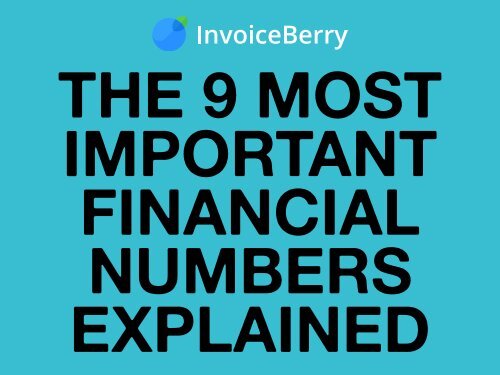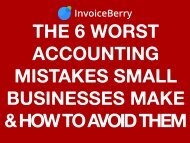The 9 Most Important Financial Numbers Explained
Check out our summary of the 9 most important financial numbers you need to know, and why your small business should watch them regularly
Check out our summary of the 9 most important financial numbers you need to know, and why your small business should watch them regularly
Create successful ePaper yourself
Turn your PDF publications into a flip-book with our unique Google optimized e-Paper software.
THE 9 MOST<br />
IMPORTANT<br />
FINANCIAL<br />
NUMBERS<br />
EXPLAINED
Introduction<br />
Small business owners are known to carry a lot of weight<br />
on their shoulders. This goes without saying.<br />
However, because they take so much upon themselves,<br />
they lack the time to really learn about the most important<br />
parts of their business. This includes finances.<br />
Finances cannot be overlooked for any business, especially<br />
the small ones or freelancers. That’s why today we’ll look at<br />
the most important financial numbers every business needs<br />
to know.
1. Cash Flow<br />
Operating cash flow is the most important part of your business<br />
and should have all your focus. To calculate this important<br />
number:<br />
Cash inflow – cash outflow = cash flow<br />
If it’s positive, and you have more inflow (money from goods<br />
and services) than outflow (bills, loan payments, taxes, etc.),<br />
your business is doing fine.
2. Net Income<br />
Also known as net profit or net earnings, your net income is very<br />
much related to your cash flow. This is a good indicator of how<br />
your business is doing, as it will help determine if you need to<br />
adjust your business, or if you are on the right path.<br />
Your income – expenses (including taxes) = net income<br />
Knowing this number will help you determine the financial<br />
position of your business.
3. Profit and Loss<br />
Your Profit & Loss (P&L or income) statement is crucial, as it<br />
gives you a snapshot of the financial status of your business. In<br />
order to calculate Profit & Loss:<br />
company revenue – company expenses = profit or loss<br />
If this numbers comes out to be positive, that means your<br />
business has made a profit. If negative, however, your business<br />
has made a loss.
4. Cost of Revenue<br />
<strong>The</strong> Cost of Revenue helps you to determine what you should<br />
charge on an hourly rate based on what it actually costs you to<br />
produce a product or service. To calculate it:<br />
Raw Materials + Direct Labor + Shipping/Transportation<br />
Costs + Sales Commission = Cost of Revenue<br />
In order to make a profit, your charges should be higher than<br />
your cost of revenue. If it is equal or less than CoR, you should<br />
be charging more.
5. Gross Margin<br />
Also known as the gross profit, this is related to your cost<br />
of revenue. It measures how much money is left over after<br />
you’ve subtracted the cost of your merchandise or services. To<br />
calculate it:<br />
Sales price – Cost to produce good/service = Gross Margin<br />
If you are in a competitive market, your margin will be quite low,<br />
but if you have a propreity goods or high quality services, your<br />
margin can be high.
6. Total Inventory<br />
For many small businesses that sesll physical goods, it’s<br />
important to measure inventory on a weekly basis to make sure<br />
that it isn’t increasing. If your inventory is increasing, this is<br />
usually an indicator of sales problems.<br />
Measure inventory on a weekly basis<br />
Your storage costs, waste, and of course reduced profits are<br />
connected to inventory, so it’s very important that you monitor<br />
your inventory number.
7. Days Sales Outstanding<br />
This is the average number of days it takes for your clients to<br />
pay your invoices. A small number is good, as it usually means<br />
more cash flow. A larger number means you need to chase your<br />
late payers. To calculate it:<br />
payment terms * 133% > Days sales outstanding<br />
If your DSO is high, you should follow one of our many tips on<br />
how to decrease payment time on invoices.
8. <strong>The</strong> Quick Ratio<br />
This number can quickly show the financial stability of your<br />
business. You get it from your balance sheet. For the quick<br />
ratio:<br />
current assets / current liabilities = quick ratio<br />
Your ratio should be greater than 1. If your ratio is unfortunately<br />
lower, that means that you’ll need to work to improve your<br />
company’s profitability.
9. Your 20% customers<br />
This is a number that has to do with the math related<br />
specifically to your customers. Basically, sort your customers<br />
by revenue, then take the top 20%. Those are your most<br />
valuable customers.<br />
<strong>The</strong> 20% highest revenue customers<br />
Know your top 20% cater to them, and work on converting the<br />
other 80% into top customers as well.
Read our full article by following the link below:<br />
<strong>The</strong> 9 <strong>Most</strong> <strong>Important</strong><br />
<strong>Financial</strong> <strong>Numbers</strong><br />
<strong>Explained</strong>
LEARN MORE ABOUT INVOICEBERRY’S<br />
ONLINE INVOICING SOFTWARE<br />
InvoiceBerry simplifies invoicing and expense tracking, helping you save your<br />
time and money. You can create your first invoice in under 60 seconds.<br />
Send<br />
Track<br />
Create<br />
Manage<br />
Track<br />
Multi-<br />
invoices<br />
expenses<br />
reports<br />
clients<br />
payments<br />
currency<br />
LEARN MORE<br />
SIGN UP
















